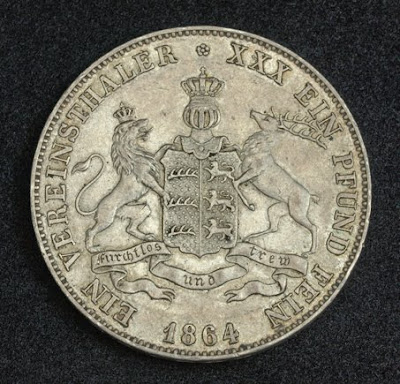Obverse: Head of William I as king of Wurttemberg left.
Legend: WILHELM KÖNIG V. WÜRTTEMBERG
Reverse: Crowned helmet ontop of halved shield with arms of Württemberg, supported by a stag and a crowned lion. Inscribed banner below.
Legend: EIN VEREINSTHALER * XXX EIN PFUND FEIN 1857
Mint Place: Stuttgart (Germany)
References: Davenport 959, KM-601.
Weight: 18.51 gm
Diameter: 33 mm
German Coins, German coinage, German silver coins, German States Coins, Coins of Germany, German Gold Coins, German commemorative coins, German Imperial Coins, Numismatic Collection, Coins of the German Empire, Coins of Germany best silver coins for investment, silver coins, German East Africa coins, old coins, coin collecting, rare coins, world coins, foreign coins, heritage coins, silver ira investment, silver bullion coins, silver coin collection investors, investment coins, antique coins, Unique Silver Coins, collectible coins, Münzen Deutschland, silbermünzen, Münzen aus Deutschland, Münzen Deutsches Kaiserreich.
William I of Württemberg (German: Wilhelm Friedrich Karl von Württemberg; 27 September 1781 – 25 June 1864) was the second King of Württemberg from 30 October 1816 until his death.
He was born in Lüben, the son of King Frederick I of Württemberg (1754–1816) and his wife, Duchess Augusta of Brunswick-Wolfenbüttel (1764–1788).
Vereinsthaler
The Vereinsthaler ("union" thaler) was a standard silver coin used in most German states and the Austrian Empire in the years before German unification.
The Vereinsthaler was introduced in 1857 to replace the previous standard Thaler (based on the Prussian Thaler) which was very slightly heavier. While the earlier Thaler had contained one fourteenth of a Cologne mark of silver (16.704 grams), the Vereinsthaler contained 16⅔ grams of silver, which was indicated on the coins as one thirtieth of a metric pound (pfund, equal to 500 grams).
The Vereinsthaler was used as the base for several different currencies. In Prussia and several other northern German states, the Vereinsthaler was the standard unit of account, divided into 30 Silbergroschen, each of 12 Pfennig. See Prussian Vereinsthaler.
In Saxony, the Neugroschen was equal to the Prussian Silbergroschen but was divided into 10 Pfennig. See Saxon Vereinsthaler. Some other north German states, such as Hanover, used the name Groschen rather than Silbergroschen for a coin of 12 Pfennig (see Hanoverian Vereinsthaler), while the Mecklenburg states and Hesse-Kassel (or Hesse-Cassel) used entirely distinct subdivisions (see Mecklenburg Vereinsthaler and Hesse-Kassel Vereinsthaler.
In southern Germany, states including Bavaria used the Gulden as the standard unit of account, with 1¾ Gulden = 1 Vereinsthaler. The Gulden was divided into 60 Kreuzer, each of 4 Pfennig or 8 Heller. See Bavarian Gulden, Baden Gulden, Württemberg Gulden.
In the Austrian Empire (and later the Austro-Hungarian Empire), a different Gulden (also known as the Florin or, in Hungarian, Forint) was the unit of account, with 1½ Gulden = 1 Vereinsthaler. The Gulden was divided into 100 Kreuzer.
German unification saw the introduction of the Goldmark at a rate of 3 mark = 1 Vereinsthaler. Consequently, the new 10 pfennig coins were equivalent to the old Groschen of northern Germany and this became a nickname for the denomination. The Vereinsthaler coins continued to circulate as 3 mark coins until 1908, when they were replaced with smaller 3 mark coins. The name Thaler for 3 marks persisted until the 1930s.
Austria-Hungary stopped issuing Vereinsthaler coins in 1867, following the Austro-Prussian War.

